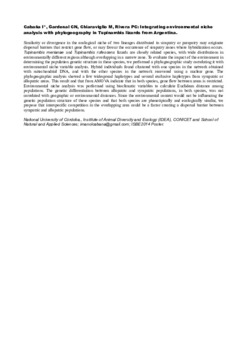| dc.contributor.author | Cabaña, Imanol | |
| dc.contributor.author | Gardenal, Cristina Noemí | |
| dc.contributor.author | Chiaraviglio, Margarita | |
| dc.contributor.author | Rivera, Paula Cecilia | |
| dc.date.accessioned | 2022-10-14T13:46:29Z | |
| dc.date.available | 2022-10-14T13:46:29Z | |
| dc.date.issued | 2015 | |
| dc.identifier.uri | http://hdl.handle.net/11086/28951 | |
| dc.description.abstract | Similarity or divergence in the ecological niche of two lineages distributed in simpatry or parapatry may originate dispersal barriers that restrict gene flow, or may favour the occurrence of simpatry zones where hybridization occurs. Tupinambis merianae and Tupinambis rufescens lizards are closely related species, with wide distributions in environmentally different regions although overlapping in a narrow zone. To evaluate the impact of the environment in determining the population genetic structure in these species, we performed a phylogeographic study correlating it with environmental niche variable analysis. Hybrid individuals found clustered with one species in the network obtained with mitochondrial DNA, and with the other species in the network recovered using a nuclear gene. The phylogeographic analysis showed a few widespread haplotypes and several exclusive haplotypes from sympatric or allopatric areas. This result and that from AMOVA indicate that in both species, gene flow between areas is restricted. Environmental niche analysis was performed using bioclimatic variables to calculate Euclidean distance among populations. The genetic differentiation between allopatric and sympatric populations, in both species, was not correlated with geographic or environmental distances. Since the environmental context would not be influencing the genetic population structure of these species and that both species are phenotipically and ecologically similar, we propose that interspecific competition in the overlapping area could be a factor creating a dispersal barrier between sympatric and allopatric populations. | es |
| dc.format.medium | Impreso | |
| dc.language.iso | eng | es |
| dc.rights | Attribution-NonCommercial-ShareAlike 4.0 International | * |
| dc.rights.uri | https://creativecommons.org/licenses/by-nc-sa/4.0/ | * |
| dc.subject | Filogeografía | es |
| dc.subject | Estructura genética | es |
| dc.subject | Nicho ambiental | es |
| dc.subject | flujo de genes | es |
| dc.title | Integrating environmental niche analysis with phylogeography in Tupinambis lizards from Argentina | es |
| dc.type | conferenceObject | es |
| dc.description.fil | FIL: Cabaña, Imanol. Universidad Nacional de Córdoba. Consejo Nacional de Investigaciones Científicas y Técnicas. Instituto de Diversidad y Ecología Animal; Argentina. | es |
| dc.description.fil | FIL: Gardenal, Cristina Noemí. Universidad Nacional de Córdoba. Consejo Nacional de Investigaciones Científicas y Técnicas. Instituto de Diversidad y Ecología Animal; Argentina. | es |
| dc.description.fil | FIL: Chiaraviglio, Margarita. Universidad Nacional de Córdoba. Consejo Nacional de Investigaciones Científicas y Técnicas. Instituto de Diversidad y Ecología Animal; Argentina. | es |
| dc.description.fil | FIL: Rivera, Paula Cecilia. Universidad Nacional de Córdoba. Consejo Nacional de Investigaciones Científicas y Técnicas. Instituto de Diversidad y Ecología Animal; Argentina. | es |
| dc.description.field | Ecología | |
| dc.conference.city | New York | |
| dc.conference.country | Estados Unidos | |
| dc.conference.editorial | XV Congress of the International Society for Behavioral Ecology | |
| dc.conference.event | XV Congress of the International Society for Behavioral Ecology | |
| dc.conference.eventcity | New York | |
| dc.conference.eventcountry | Estados Unidos | |
| dc.conference.eventdate | 2014-8 | |
| dc.conference.institution | International Society for Behavioral Ecology | |
| dc.conference.journal | libro de resumen de XV Congress of the International Society for Behavioral Ecology | |
| dc.conference.publication | Libro | |
| dc.conference.work | Resumen | |
| dc.conference.type | Congreso | |





